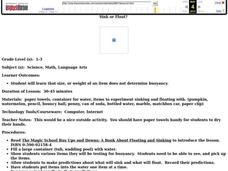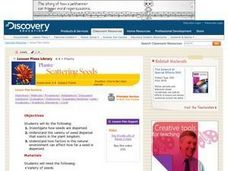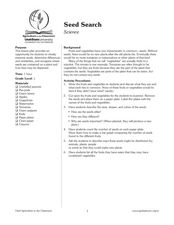Curated OER
Wonderful Watermelon Unit
Students get involved in an integrated unit on watermelons. They get knowledgeable about watermelons. This activity involves each student decorating a watermelon and predicting the outcome of it.
Baylor College
We Need Water
There's nothing quite like a glass of ice-cold, freshly squeezed lemonade. Lesson seven of this series explains how the water humans need to survive can come in many forms. Teach your class about how much water humans require every day...
Curated OER
Does the Seed Matter?
Students compare the growth of watermelon from commercial seeds and those harvested from a watermelon. They complete science journals showing these comparisons based on the data they collect.
Curated OER
Fruit or Vegetable?
Watermelon is a vegetable? A tomato is a fruit? Believe it or not, this debate is decades old. Groups examine rulings by the US Supreme Court, the USDA, and state statutes before developing their own criteria to use when labeling the...
Curated OER
Scientific Method and Graphing
Seventh graders use the scientific method to determine how many seeds are in a watermelon.
Curated OER
Solar Energy - Dehydration
Sixth graders explore process of drying food using solar energy. They cook and/or dry food such as pumpkins, watermelon, corn, and deer meat, explain how solar energy changes foods, and compare and contrast solar energy with other forms...
Curated OER
Estimation of Population Growth by Counting Offspring: Seed Multiplication
Learners analyze a multi-seeded fruit, such as tomato, pepper, squash, watermelon, etc. They remove and count the seeds from the fruit and hypothesize/calculate the reproductive rate of that organism.
Oklahoma Ag in The Classroom
Bee Smart Bee Happy
Here is a wonderfully designed activity on bees and pollination designed for early elementary learners. After a class discussion on bees, pupils pretend to be a bee by picking up nectar off of "flowers" in the class. The flowers are...
American Museum of Natural History
The Tree of Life
Groups of species can have more in common than meets the eye. An interactive cladogram shows some of the connections between important groups of species. Learners click on sections of the diagram to learn more about the connections or on...
Curated OER
Beans and Baleen
Predict whale populations using different beans as whales! Learners observe different types of beans in a dish knowing that each bean represents a different kind of whale. They then predict how many "whales" there are in a certain area....
Curated OER
Sink or Float?
Students predict and test different items to see if they sink or float. In this sink and float lesson plan, students predict whether an item is buoyant or not, and learn that size and weight do not matter when it comes to buoyancy.
Curated OER
The Enormous "Kinder" Garden
Students discover books about planting enormous things. In this reading lesson plan, students experience several books centered around growing enormous plants. Cross curricular activities are included
Curated OER
Plants: Scattering Seeds
Students collect and microscopically examine seeds from the school yard and neighborhood. In small groups, they draw and discuss the shapes of the seeds to determine each plant's method of dispersal. they also test two types of seeds...
Curated OER
Seed Search
First graders examine seeds. In this fruits and vegetables lesson plan, 1st graders determine what fruits and vegetables have in common. Students cut open fruits and vegetables and examine their seeds. Students describe the sizes, shapes...
Curated OER
Measuring Transpiration
In this transpiration learning exercise, students will conduct an experiment to measure the rate of transpiration from a plant by measuring how much weight the plant loses over 5 days. Students will record their data and create a graph...
Curated OER
Farming Number 6
In this environment worksheet, students identify and explain the importance of water and farming. They identify the differences between food items and whether they are a fruit, vegetable, or animal. Students also respond to 5 yes/no...
Curated OER
Horticulture and Gardening
In this colorful packet, students engage in a variety of activities involving plants and seeds. After answering the 50 questions in the packet, learners can go on to delve into their own projects.
Curated OER
Parts of the Seed
In this biology learning exercise, students read about the parts of plant seeds and look at a seed diagram. They read about the roots, endosperm, embryo, and the process of germination. They answer 8 online multiple choice questions...
Curated OER
Physical and Chemical Changes-Notes
In this physical and chemical change learning exercise, students watch a movie called the "Brain POP" about property changes and fill in the blanks to complete 8 sentences which are examples of chemical and physical changes.
Curated OER
Native Lands: Indians in Georgia
Students investigate the Native Americans of the Muscogee Creek and their use of the land. In this U.S. history activity, students investigate the importance of the deer for the Muscogee Creek peoples' way of life and the many uses they...
Curated OER
Ag in My Community; Agriculture
Students build knowledge about agriculture as it relates to their communities' commodities. In this agriculture lesson, students brainstorm about conditions in their community with regards to growing different types of crops. Students...
Curated OER
Lesson Plan Five: Sense of Smell and The Nose
Students identify five different fruits by using their sense of smell, and then draw a picture of the fruit; students create their own picture, and add spices for scent.
Curated OER
Worm Composting: Vermiculture
Students set up their own composting bin. They observe and record their findings during a period of time. They describe the decomposing process as well.
Curated OER
Sock Walk
First graders, after brainstorming all the ways seeds are scattered and viewing a multitude of examples of seeds, explore how seeds travel by taking a walk outdoors wearing socks over their shoes. In addition, they assess how seeds...
Other popular searches
- The Enormous Watermelon
- Watermelon Day
- Watermelon Seed Growth
- Watermelon Day Story
- Enormous Watermelons
- Watermelon Poems
- Watermelon Seeds
- Life Cycle of Watermelons
- Watermelon Crawl
- Enormous Watermelon Close
- Root Systems of Watermelons
- Enormous Watermelon Cloze

























